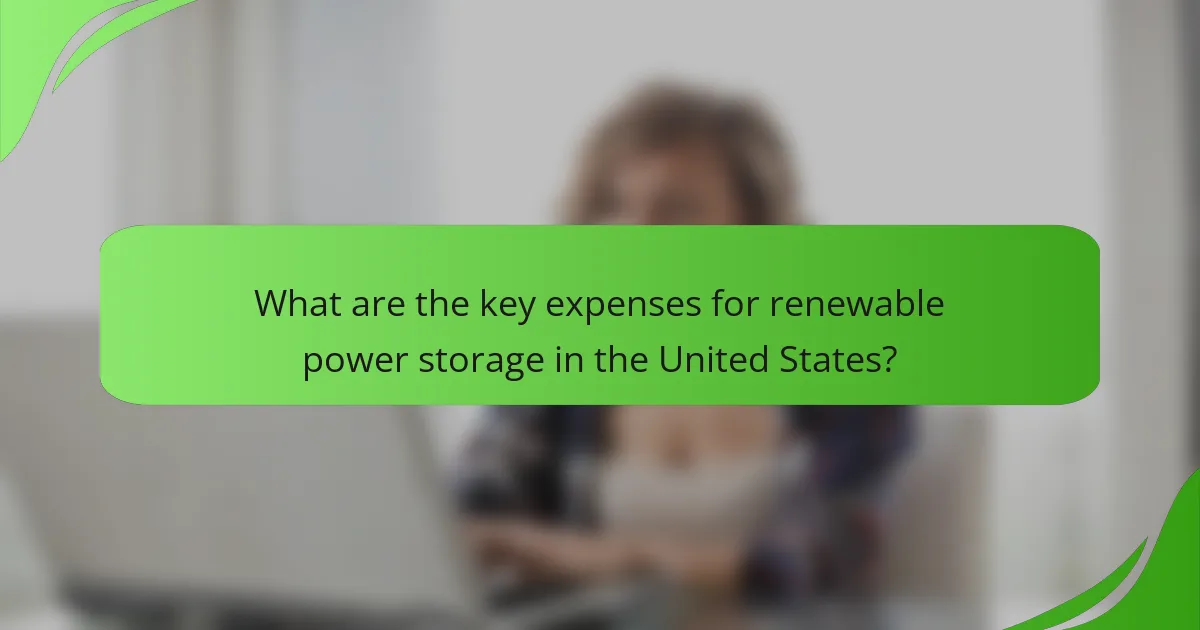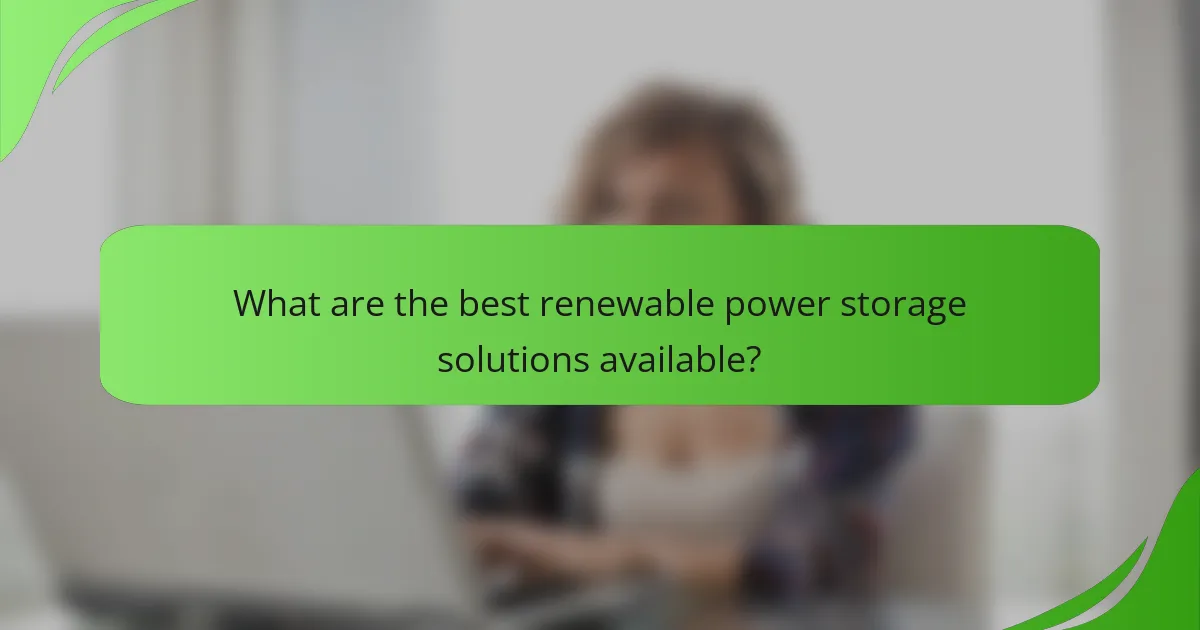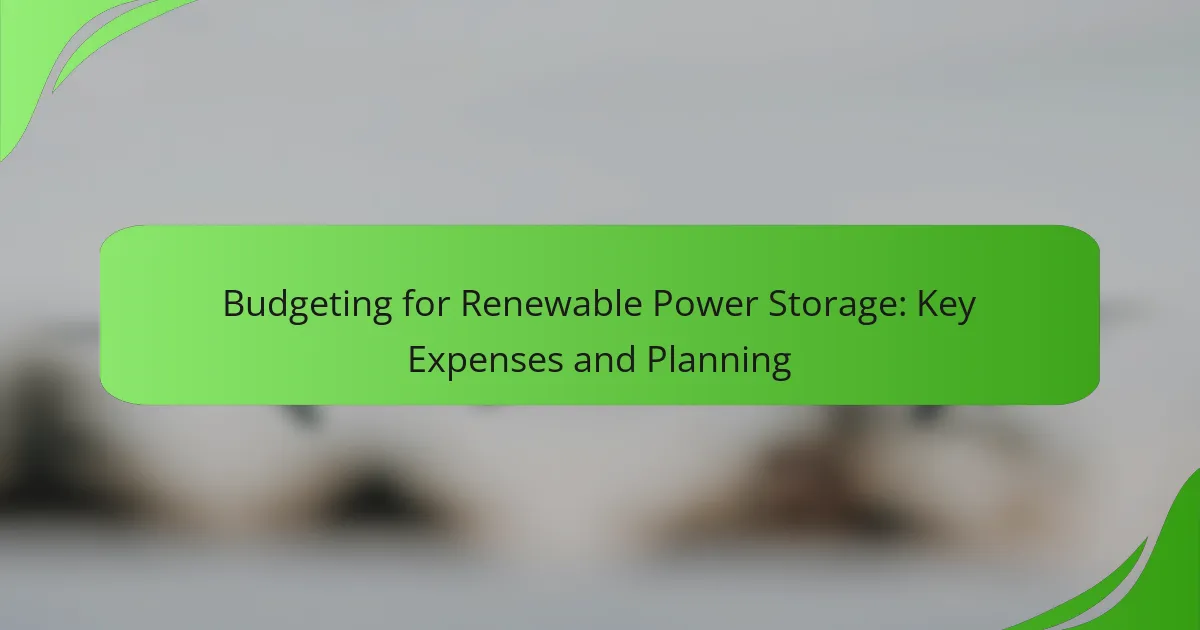Budgeting for renewable power storage is essential for maximizing the benefits of energy systems powered by sources like solar and wind. Key expenses include battery costs, installation, maintenance, and regulatory fees, all of which must be carefully assessed to create an effective financial plan. By understanding these costs and evaluating storage options, stakeholders can ensure reliable energy management and optimize their investments in renewable technologies.

What are the key expenses for renewable power storage in the United States?
The key expenses for renewable power storage in the United States include battery costs, installation expenses, maintenance fees, permitting and regulatory costs, and insurance and financing. Understanding these expenses is crucial for effective budgeting and planning for renewable energy projects.
Battery costs
Battery costs represent a significant portion of the total investment in renewable power storage. Prices can vary widely depending on the type of battery technology used, such as lithium-ion or flow batteries, with costs typically ranging from several hundred to a few thousand dollars per kilowatt-hour (kWh) of storage capacity.
When budgeting for battery costs, consider factors like the expected lifespan, efficiency, and energy density of the batteries. Investing in higher-quality batteries may lead to lower replacement costs over time, making it a worthwhile consideration.
Installation expenses
Installation expenses encompass labor, equipment, and site preparation costs associated with setting up renewable power storage systems. These costs can vary based on the complexity of the installation and the specific site conditions, often ranging from a few thousand to tens of thousands of dollars.
To minimize installation expenses, it is advisable to obtain multiple quotes from qualified contractors and ensure that the installation is performed by experienced professionals familiar with local regulations and standards.
Maintenance fees
Maintenance fees are ongoing costs necessary to ensure the reliability and efficiency of renewable power storage systems. These fees can include routine inspections, repairs, and replacement of components, typically amounting to a small percentage of the initial investment annually.
Regular maintenance is essential to prolong the lifespan of the storage system and prevent costly breakdowns. Establishing a maintenance schedule and working with qualified service providers can help manage these expenses effectively.
Permitting and regulatory costs
Permitting and regulatory costs involve expenses related to obtaining the necessary approvals and licenses to install and operate renewable power storage systems. These costs can vary significantly based on local regulations and may include application fees, environmental assessments, and compliance with safety standards.
To navigate permitting efficiently, familiarize yourself with local regulations early in the planning process. Engaging with local authorities and seeking guidance from experts can help streamline this aspect and avoid unexpected delays or costs.
Insurance and financing
Insurance and financing costs are critical components of budgeting for renewable power storage. Insurance may cover potential damages or liabilities, while financing costs can include interest on loans or other financial products used to fund the project.
When considering insurance, evaluate policies that specifically cover renewable energy systems. For financing, explore various options such as government incentives, grants, or low-interest loans that can help reduce overall costs and improve project viability.

How to plan a budget for renewable power storage?
Planning a budget for renewable power storage involves assessing energy needs, evaluating storage options, calculating total costs, and considering financing methods. A well-structured budget ensures that you can effectively manage expenses while maximizing the benefits of renewable energy systems.
Assess energy needs
Start by determining your energy consumption patterns and requirements. Analyze your current electricity usage to identify peak demand times and total monthly consumption, which can help you decide how much storage capacity you need.
Consider factors like seasonal variations in energy use and potential future increases in demand. For instance, if you plan to add electric vehicles or expand your home, factor in these changes when assessing your energy needs.
Evaluate storage options
Research various renewable power storage technologies, such as lithium-ion batteries, flow batteries, and pumped hydro storage. Each option has different capacities, lifespans, and costs associated with installation and maintenance.
Compare the advantages and disadvantages of each storage type. For example, lithium-ion batteries are popular for residential use due to their compact size and efficiency, while pumped hydro may be more suitable for larger installations requiring significant energy storage.
Calculate total cost of ownership
To calculate the total cost of ownership (TCO), consider not only the initial purchase price but also installation, maintenance, and operational costs over the system’s lifespan. This comprehensive approach helps you understand the long-term financial implications of your storage solution.
Include potential savings from reduced electricity bills and any available incentives or rebates. For example, in the U.S., federal tax credits can significantly lower the upfront costs of renewable storage systems.
Consider financing options
Explore various financing options to fund your renewable power storage system. Common methods include loans, leases, and power purchase agreements (PPAs), each with its own terms and conditions.
Research local incentives and programs that may offer favorable financing terms or grants. For instance, some regions provide low-interest loans for renewable energy projects, making it easier to manage upfront costs while investing in sustainable energy solutions.

What are the best renewable power storage solutions available?
The best renewable power storage solutions include advanced battery systems designed to store energy generated from renewable sources like solar and wind. These systems enhance energy reliability and efficiency, allowing users to manage their energy consumption effectively.
Tesla Powerwall
The Tesla Powerwall is a popular home battery solution that stores energy from solar panels or the grid. It has a capacity of around 13.5 kWh, making it suitable for daily energy needs and backup power during outages.
When considering the Powerwall, evaluate installation costs, which can range from a few thousand to over ten thousand USD, depending on the setup. Additionally, its integration with solar systems can optimize energy use and reduce electricity bills.
Sonnen Eco
The Sonnen Eco is a smart energy storage system that offers modular battery solutions, allowing users to scale their storage needs. With capacities starting at about 10 kWh, it is designed for both residential and commercial applications.
One key feature of the Sonnen Eco is its ability to connect to a community energy network, enabling users to share excess energy. This can lead to lower energy costs and increased sustainability, but initial investment can be significant, often exceeding ten thousand USD.
LG Chem RESU
The LG Chem RESU series provides compact and efficient energy storage options, with capacities ranging from 6.5 kWh to 16 kWh. These batteries are designed for residential use and can be paired with solar systems for optimal performance.
Consider the RESU’s compatibility with various inverters and its warranty, which typically lasts around ten years. Pricing varies, but expect to invest several thousand USD for a complete system, including installation.
Enphase Encharge
The Enphase Encharge is a modular battery storage solution that allows for flexible scaling based on energy needs. Each unit has a capacity of about 10 kWh, making it suitable for homes with moderate energy consumption.
Enphase’s system is designed for seamless integration with its solar microinverters, enhancing overall system efficiency. Installation costs can vary, but a complete setup generally falls within the range of several thousand to over ten thousand USD, depending on the number of units installed.

What factors influence the cost of renewable power storage?
The cost of renewable power storage is influenced by various factors, including the technology type, system size, and the complexity of installation in a specific location. Understanding these elements can help in planning and budgeting for renewable energy projects effectively.
Technology type
The type of technology used for renewable power storage significantly impacts costs. Common technologies include lithium-ion batteries, flow batteries, and pumped hydro storage, each with different price points and performance characteristics. For instance, lithium-ion batteries are widely used due to their efficiency and decreasing costs, while pumped hydro systems can be more economical for large-scale applications but require specific geographical conditions.
When selecting a technology, consider factors such as lifespan, efficiency, and maintenance costs. For example, while lithium-ion batteries may have lower upfront costs, their lifespan and replacement costs should be factored into the overall budget.
System size
The size of the storage system directly correlates with its cost. Larger systems often benefit from economies of scale, reducing the per-unit cost of storage. For instance, a residential battery system may cost significantly more per kilowatt-hour than a utility-scale installation due to the smaller scale of production and installation.
When planning, assess your energy needs to determine the appropriate system size. A common approach is to calculate the total energy consumption and desired backup duration, which can help in estimating the required capacity and associated costs.
Location and installation complexity
The location of the renewable power storage system plays a crucial role in determining installation costs. Factors such as accessibility, local regulations, and site preparation can influence the overall expense. For example, installing a system in a remote area may incur higher transportation and labor costs.
Additionally, the complexity of installation can vary based on the site’s characteristics. Sites requiring extensive groundwork or those with challenging terrain may lead to increased labor and material costs. It is advisable to conduct a thorough site assessment and consult with local contractors to get accurate estimates.
